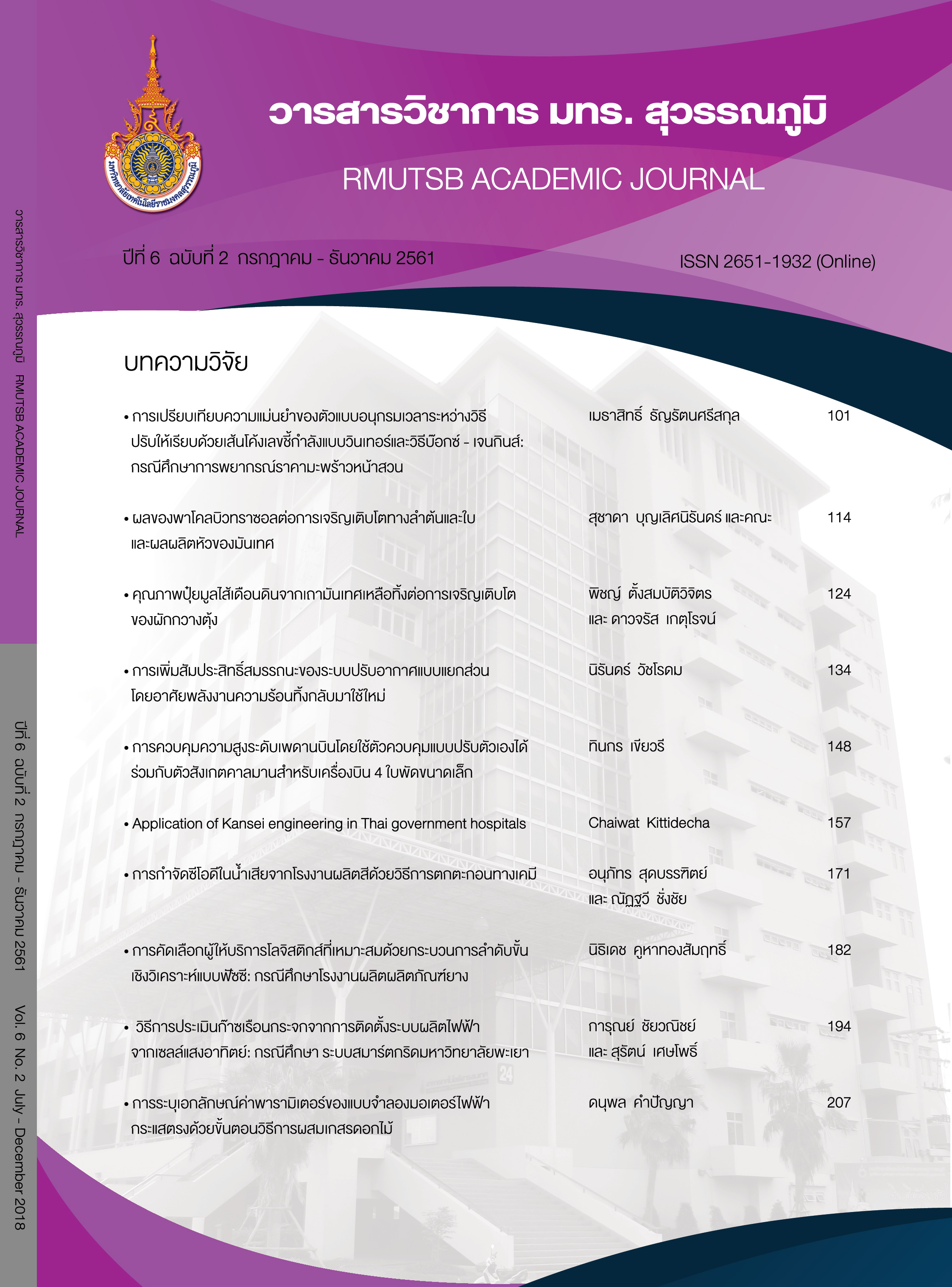The paint factory’s wastewater: COD removal by chemical precipitation method
Main Article Content
Abstract
Wastewater from paint factory contains various heterogeneity compounds and needs appropriate treatment before released into environment. The objectives of this research were to evaluate the optimum condition of coagulants (ferric chloride and polyaluminium chloride) i.e. coagulant dosage and pH, and to compare the COD removal efficiencies of the coagulants. Wastewater samples were collected from a tank of spray painting process and it was subjected to study COD removal by using chemical precipitation method through Jar test experiment. The average values of raw wastewater characteristic were pH 7.01+0.03, turbidity 803.67+8.14 NTU, color 440.80+1.86 SU, and COD 1,120+13.23 mg/L. Result of the study found that an optimum condition for ferric chloride was 500 mg/L at pH 5 with 33.04% the highest efficiency in COD removal. In addition, an optimum condition for polyaluminium chloride was 600 mg/L at pH 7 with 37.90% the highest efficiency in COD elimination. Result demonstrated that the effective in COD removal of polyaluminium chloride was very similar to ferric chloride.
Article Details
Published manuscript are the rights of their original owners and RMUTSB Academic Journal. The manuscript content belongs to the authors' idea, it is not the opinion of the journal's committee and not the responsibility of Rajamangala University of Technology Suvarnabhumi
References
ภักดี ฐานปัญญา. (2526). เทคนิคการซ่อมตัวถังและพ่นสีรถยนต์ (พิมพ์ครั้งที่ 2). กรุงเทพฯ: โรงพิมพ์พิทักษ์อักษร.
อิสวัต แสงมณี, กรกฏ เพ็ชร์หัสณะโยธิน, และสุธน เสถียรยานนท์. (2552). สภาวะที่เหมาะสมสำหรับการบำบัดน้ำเสียจากโรงงานผลิตชิ้นส่วนอิเล็กทรอนิกส์. วารสารก้าวทันโลกวิทยาศาสตร์, 9(1), 143-151.
Aboulhassan, M. A., Souabi, S., Yaacoubi, A., & Baudu, M. (2014). Treatment of paint manufacturing wastewater by combination of chemical and biological process. International Journal of Science, Environment and Technology, 3(5), 1747-1758.
Aguilar, M. I., Saez, J., Liorens, M., & Fuentes, A. (2005). Improvement of coagulation-flocculation process using anionic polyacrylamide as coagulant aid. Chemosphere, 58(1), 47-56.
Altaher, H., El Qada, E., & Omar, W. (2011). Pretreatment of wastewater streams from petroleum/petrochemical industries using coagulation. Advances in Chemical Engineering and Science, 1, 245-251.
American Public Health Association (APHA), American Water Works Association (AWWA) and Water Environment Federation (WEF). (2012). Standard methods for the examination of water and wastewater (20th ed). Baltimore, Maryland: United Book Press.
Aziz, H. A., Alias, S., Assari, F., & Adlan, M. N. (2007). The use of alum, ferric chloride and ferrous sulphate as coagulants in removing suspended solids, colour and COD from semi-aerobic landfill leachate at controlled pH. Waste Management & Research, 25(6), 556-565.
Crittenden, J. C., Trussell, R. R., Hand, D. W., Howe, K. J., & Tchobanoglous, G. (2005). Water treatment principles and design. New Jersey: John Wiley & Sons.
Ebeling, J. M., Philip, L., Sibrell, B., Sarah, R., Ogden, A., & Summerfelt, S. T. (2003). Evaluation of chemical coagulation-flocculation aids for the removal of suspended solids and phosphorus from intensive recirculating aquaculture effluent discharge. Aquacultural Engineering, 29(1-2), 23-42.
Guo, J. S., Abbas, A. A., Chen, Y. P., Liu, Z. P., Fang, F., & Chen, P. (2010). Treatment of landfill leachate using a combined stripping, fenton, SBR, and coagulation process. Journal of Hazardous Materials, 178(1-3), 699-705.
Johnson, P. N., & Amirtharajah, A. (1983). Ferric chloride and alum as single and dual coagulants. Journal AWWA, 75(5), 232-239.
Renault, F., Sancey, B., Badot, P. M., & Crini, G. (2009). Chitosan for coagulation/flocculation processes: An eco-friendly approach. European Polymer Journal, 45(5), 1337-1348.
Rui, L. M., Duad, Z., & Latif, A. A. A. (2012). Coagulation-Flocculation in leachate treatment by using ferric chloride and alum as coagulant. International of Engineering Research and Applications, 2(4), 1929-1934.
Sinha, S., Yoon, Y., Amy, G., & Yoon, J. (2004). Determining effectiveness of conventional and alternative coagulants through effective characterization schemes. Chemosphere, 57(9), 1115-1122.
Szygula, A., Guibal, E., Palacin, M. A., Ruiz, M., & Sastre, A. M. (2009). Removal of an anionic dye (Acid Blue 92) by coagulation-flocculation using chitosan. Journal of Environmental Management, 90(10), 2979-2986.
Tripathy, T., & De, B. R. (2006). Flocculation: A new way to treat the waste water. Journal of Physical Sciences, 10, 93-127.
Tzoupanou, N. D., & Zouboulis, A. I. (2008). Coagulation-flocculation processes in water/wastewater treatment: The application of new generation of chemical reagents. In Proceedings of 6th IASME/WSEAS International Conference on Heat Transfer (pp. 309-317), Greece: Thermal Engineering and Environment.
Wang, J. P., Chen, Y. Z., Ge, X. W., & Yu, H. Q. (2007). Optimization of coagulation-flocculation process for a paper recycling wastewater treatment using response surface methodology. Colloids and Surfaces A: Physiochemical and Engineering Aspect, 302(1-3), 204-210.
Yang, Z. L., Gao, B. Y., Yue, Q. Y., & Wang, Y. (2010). Effect of pH on the coagulation performance of Al-based coagulants and residual aluminum speciation during the treatment of humic acid – kaolin synthetic water. Journal of Hazardous Materials, 178(1-3), 596-600.


